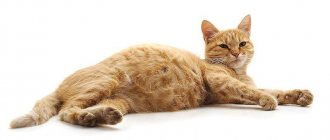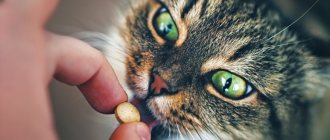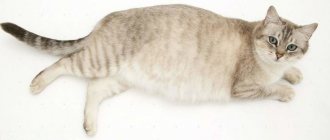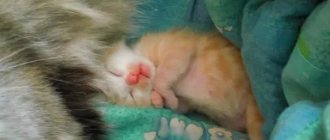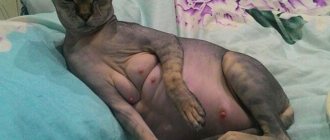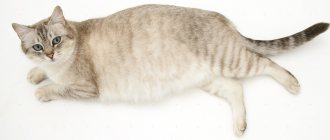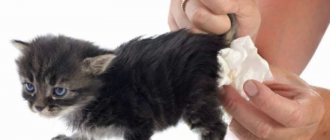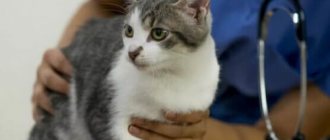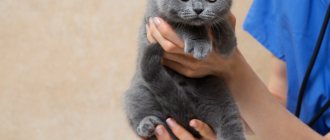The cat's pregnancy calendar will help you correctly calculate the due date, as well as find out how the fetuses develop in a certain week. In the first days after a successful mating, conception occurs. The fertilized egg begins its further development path, and after 60-70 days the long-awaited kittens will be born. In British, Scottish cats, and female Sphynx cats, the duration of pregnancy is almost the same. But the duration of gestation of offspring is influenced by various factors, including age, conditions of keeping and feeding when the first mating took place.
Signs of pregnancy
Already in the first days of pregnancy, a British cat's behavior and character begin to change. She becomes especially affectionate, lethargic and inactive. She also begins to fall asleep frequently, and the animal exhibits an increased appetite. In some cases, the opposite situation occurs: toxicosis occurs, which leads to nausea and aversion to food.
After the first month of pregnancy, the following signs appear:
- the cat's nipples change their color to pink, slight swelling and flaking appear,
- the abdomen is noticeably rounded, which indicates the successful beginning of fetal formation,
- appetite increases significantly,
- hormonal changes and stretching of the uterus can lead to frequent vomiting in the morning,
- the cat completely ignores males, her estrus stops (in some cases, estrus continues in the early stages),
- taste preferences change
In the fourth week, you can already perform an x-ray or ultrasound (these procedures are contraindicated at an earlier stage). The presence or absence of pregnancy, as well as its duration, can be determined by the doctor after palpating the cat’s abdomen. You should not touch it yourself - careless movements can easily harm the fetus and even cause a miscarriage.
It is worth remembering the day on which conception occurred, this will help determine the approximate due date.
How to find out if a British woman is pregnant
If the British woman and her chosen one are healthy, and fertilization has occurred successfully, within one and a half to two weeks after mating the owner may notice the first signs of pregnancy:
- Possible toxicosis (not all cats have it) – the pet feels nauseous, its appetite is reduced;
- Change in the shade of the nipples (all or several) - they become distinctly pink;
- The cat tends to fall asleep - the pregnant pet will prefer solitude in a secluded corner to active games.
In the middle of pregnancy, the owner of a British cat will notice more obvious signs of an imminent addition to the mustachioed family:
- The cat's belly is rounded, which is noticeable to the naked eye;
- The animal's appetite increases;
- The nipples become swollen.
In the last 3 weeks before giving birth, the cat behaves like a real expectant mother:
- Relaxes a lot - saves strength before the birth of kittens;
- Looks for a “nest” - a corner for offspring, spends a lot of time there.
Immediately before giving birth (24-12 hours or less), the pet begins to produce milk, breathes frequently, meows anxiously, and licks the perineum. 2-3 hours before a joyful event or immediately before the birth itself, the cat’s water breaks - a gray-yellow liquid. Half an hour to an hour before the moment of birth, contractions begin.
Length of pregnancy
It is impossible to say unequivocally how long a cat’s pregnancy will last. The average duration according to the calendar is 63-65 days, but the exact number of days cannot be determined for a number of reasons.
- Small cats weighing up to 2.5 kilograms can give birth earlier than usual - on days 56-60 of pregnancy. British cats over 5 kg can give birth even after the 65th day.
- In the case of the first pregnancy, a cat that carries less than 3 kittens most often gives birth at 60-65 days.
- A cat that is bearing kittens not for the first time can give birth earlier - on the 56-60th day.
- The length of pregnancy also depends on the number of babies in the womb: the more kittens, the higher the likelihood of premature birth
What to feed a pregnant Maine Coon cat
Errors in the preparation of diet for animals in position, insufficient supply of nutrients to the body, can cause abnormal development of bones, organs and stunted growth of the young. Food for pregnant cats should be varied and complete. It is important to observe this condition, especially in the first month of fetal development - during the laying of the baby’s organs.
Each stage of Maine Coon cat pregnancy will require changes in the quality and quantity of food. The gestation period is 65 days, which is 9 weeks. During this period, a high-calorie diet rich in microelements, vitamins and protein is necessary.
In the first 2 weeks of the pregnancy, the size of the pregnant woman’s usual diet is increased slightly - by only 10%. This does not mean increasing the serving size; a cat’s stomach is small; you just need to increase feeding to 4-5 times a day.
The third week will require 50% more food, but overfeeding is unacceptable: it can lead to obesity in kittens and severe complicated births.
Starting from the seventh week, the female’s appetite decreases, which is caused by increased pressure in the peritoneum, which is overfilled with fruits. Now you need to feed the coon less, 3 times a day is enough. The mother’s body needs unloading; babies no longer require increased nutrition. If you completely refuse food, you should give the animal rest - this may be a symptom of the onset of labor.
What foods are necessary for a pregnant Maine Coon?
The diet of a kitty in an interesting situation should be compiled taking into account age, size, and breed. The necessary nutrients and vitamins must be present. Taking into account the usefulness, the basis of the diet of a pregnant Maine Coon cat is beef meat, which in its raw form makes up half of the daily volume of food.
You can diversify the menu with boiled lean fish - “murki” love this product. It should be remembered: you cannot abuse such dishes - fish products are not recommended for a purebred cat. Milk and dairy products are included in the food, but only after the animal has eaten the main food, this will prevent digestive disorders of the expectant mother.
- fermented milk drinks, cottage cheese; yolk; boiled turkey, chicken; cereal products (buckwheat, rice); vegetables (zucchini, carrots, cabbage) as an addition to a meat dish.
If your mustachioed pet is habitually fed with ready-made dry food and canned food, you should give them products developed specifically for pregnant cats.
Constipation often occurs during Maine Coon pregnancy. In such cases, your pet can be given Vaseline oil at the rate of 1 ml per 1 kg. You can introduce wheat, oats, vegetable purees flavored with vegetable fat into the diet.
Treats, cheap food of low quality, full of harmful chemicals - flavorings and dyes - are not allowed for Maine Coon cats. You cannot give food from the table. You need to understand that in order for the fluffy beauty to happily run to her bowl, the food must be not only healthy, but also tasty.
What professional breeders advise
Some nursery owners and specialists in breeding the breed know everything about feeding Maine Coons. Breeders advise giving females ready-made kitten food containing the necessary components: calcium, minerals, proteins. The daily portion of a cat increases 4 times; a larger volume causes excess body weight for mothers and babies. Changing product brands during pregnancy is unacceptable.
.
Start of labor
After 50-55 days, you can feel the kittens moving in their stomachs. During this period, the cat begins to choose the best place in the house to give birth, secluded and warm.
The first sign of labor in a cat is a drooping belly and very swollen nipples. Yellow-brown mucus (birth plug) may also come out of the genital tract. A few days before giving birth, the cat's body temperature drops to 37 degrees.
Before giving birth, the cat’s behavior also changes: she begins to lick herself more frequently, especially in the genital area and abdomen. During this period, increased anxiety is the norm for the animal; it may meow frequently and even dig in the maternity box.
During the period before giving birth, the cat needs to be monitored especially carefully: some “quiet” ones can give birth suddenly, without showing prenatal symptoms. The owner may not notice the plug that has come out and the water that has broken. Well, a cat can even give birth to her first kitten without making a single sound.
Pet care
A cat, like a woman, needs comfortable conditions to bear offspring. Monitor your cat's pregnancy with doctors and contact a specialist if there are any abnormalities. Provide good healthy nutrition and surround with warmth and care.
During pregnancy, the cat should be in comfortable conditions
Bearing and giving birth to offspring is a very difficult and serious stage in a cat’s life, especially for the first time. A cat cannot always cope on its own, so you must help it survive this exciting moment and rejoice at the birth of little cute lumps.
Pregnancy calendar with a duration of 65 days
| January | February | March | April | May | June | July | August | September | October | November | December | |
| Mating | 01.01. | 01.02. | 01.03. | 01.04. | 01.05. | 01.06. | 01.07. | 01.08. | 01.09. | 01.10. | 01.11. | 01.12. |
| Childbirth | 07.03. | 07.04. | 0505. | 05.06. | 05.07. | 05 08. | 04.09. | 05 10 | 05.11. | 05.12 | 05.01. | 04.02. |
| Mating | 02.01. | 02.02. | 02.03. | 02.04. | 02.05. | 02.06. | 02.07. | 02.08. | 02.09. | 02.10. | 02.11 | 02.12. |
| Childbirth | 08.03. | 08.04. | 06.05. | 06.06. | 06.07. | 06.08. | 05.09. | 06.10. | 06.11. | 06.12. | 06.01. | 05.02. |
| Mating | 03.01. | 03.02. | 03.03. | 03.04. | 03.05. | 03 06. | 03.07. | 03.08. | 03.09. | 03.10. | 03.11. | 03.12. |
| Childbirth | 09.03. | 09.04. | 07.05. | 07.06. | 07.07. | 07.08. | 06.09. | 07.10. | 07.11. | 07.12. | 07.01. | 06.02. |
| Mating | 04.01. | 04.02. | 04.03. | 04.04. | 04.05. | 04.06. | 04.07. | 04.08. | 04.09. | 04.10. | 04.11. | 04.12. |
| Childbirth | 10.03. | 10.04. | 08.05. | 08.06. | 08.07. | 08.08. | 07.09. | 08.10. | 08.11. | 08.12. | 08.01. | 07.02. |
| Mating | 05.01. | 05.02. | 05.03. | 05.04. | 05.05. | 05.06. | 05.07. | 05.08. | 05.09. | 05.10. | 05.11. | 05.12. |
| Childbirth | 11.03. | 11.04. | 09.05. | 09.06. | 09.07. | 09 08. | 08.09. | 09 10. | 09.11. | 09.12 | 09.01. | 08.02. |
| Mating | 06.01. | 06 02 | 06.03. | 06.04. | 06.05. | 06.06. | 06.07. | 06 08. | 06.09. | 06.10. | 06.11. | 06.12. |
| Childbirth | 12.03. | 12.04. | 1005. | 10.06. | 10.07. | 1008. | 09.09. | 10.10. | 10.11. | 10.12. | 1001. | 09.02. |
| Mating | 07.01. | 07.02 | 07.03. | 07.04. | 07.05. | 07 06. | 07.07. | 07.08. | 07.09. | 07.10. | 07.11. | 07.12. |
| Childbirth | 13.03. | 13.04. | 11.05. | 11.06. | 11.07. | 11.08. | 10.09. | 11.10. | 11.11. | 11.12. | 11.01. | 10.02. |
| Mating | 08.01. | 08.02. | 08.03. | 08.04. | 08.05. | 08.06. | 08.07. | 08.08. | 08.09. | 08.10. | 08.11. | 08.12. |
| Childbirth | 14.03. | 14.04. | 12.05. | 12.06. | 12.07. | 12.08. | 11.09. | 12.10. | 12.11. | 12.12. | 12.01. | 11.02. |
| Mating | 09.01. | 09.02. | 09.03. | 09.04. | 09.05. | 09.06. | 09.07. | 09.08. | 09.09. | 09.10. | 09.11. | 09.12. |
| Childbirth | 15.03. | 15.04. | 13.05. | 13.06. | 13.07. | 13.08. | 12.09. | 13.10. | 13.11. | 13.12. | 1301. | 12.02. |
| Mating | 10.01. | 10.02. | 10.03. | 10.04 | 10.05. | 1006. | 10.07. | 10.08. | 10.09. | 10.10. | 10.11. | 10.12. |
| Childbirth | 16.03. | 16.04. | 14.05. | 14.06. | 14.07. | 14.08. | 13.09. | 14.10. | 14.11. | 14.12. | 14.01. | 13.02. |
| Mating | 11.01. | 11.02. | 11.03. | 11.04. | 11.05. | 11.06. | 11.07. | 11.08. | 11.09. | 11.10. | 11.11. | 11.12. |
| Childbirth | 17.03. | 17.04. | 15.05. | 15.06. | 15.07. | 15.08. | 14.09. | 15.10. | 15.11. | 15.12. | 15.01. | 14.02. |
| Mating | 12.01. | 12.02. | 12.03. | 12.04. | 12.05. | 12.06. | 12.07. | 12.08. | 12.09. | 12.10. | 12.11. | 12.12. |
| Childbirth | 18.03. | 18.04. | 16.05. | 16.06. | 16.07. | 16.08. | 15.09. | 16.10. | 16.11. | 16.12. | 16.01. | 15.02. |
| Mating | 13.01. | 13.02. | 13.03. | 13.04. | 13.05 | 1306. | 13.07. | 13.08. | 13.09. | 13.10. | 13 11. | 13.12. |
| Childbirth | 19.03. | 19.04. | 17.05. | 17.06. | 17.07. | 17.08. | 16.09. | 17.10. | 17.11. | 17.12. | 17 01. | 16.02. |
| Mating | 14.01. | 14.02. | 14.03. | 14.04. | 14.05. | 14 06. | 14.07. | 14.08. | 14.09. | 14.10. | 14.11. | 14.12. |
| Childbirth | 20.03. | 20.04. | 18.05. | 18.06. | 18.07. | 18.08. | 17.09. | 18.10. | 18.11. | 18.12. | 18.01. | 17.02. |
| Mating | 15.01. | 15.02. | 15.03. | 15.04. | 15.05. | 15.06. | 15.07. | 15.08. | 15.09. | 15.10. | 15.11. | 15.12. |
| Childbirth | 21 .03. | 21.04. | 19.05. | 19.06. | 19.07. | 19.08. | 18.09. | 19.10. | 19.11. | 19.12. | 19.01. | 18.02. |
| Mating | 16.01. | 16.02. | 16.03. | 16.04. | 16.05. | 16.06. | 16.07. | 16.08. | 16.09. | 16.10. | 16.11. | 16.12. |
| Childbirth | 22.03. | 2.2.04. | 20.05. | 20.06. | 20.07. | 20.08. | 19.09. | 20.10. | 20.11. | 20.12. | 20.01. | 19.02. |
| Mating | 17.01. | 17.02. | 17.03. | 17.04. | 17.05. | 17.06. | 17.07. | 17.08. | 17.09. | 17.10. | 17.11. | 17.12. |
| Childbirth | 23.03. | 23.04. | 21.05. | 21.06. | 21.07. | 21.08. | 20.09. | 21.10. | 21.11. | 21.12. | 21.01. | 20.02. |
| Mating | 18.01. | 18.02. | 18.03. | 18.04. | 18.05. | 1806. | 18.07. | 18.08. | 18.09. | 18.10. | 18.11. | 18.12. |
| Childbirth | 24.03. | 24.04. | 22.05. | 22.06. | 22.07. | 22.08. | 21.09. | 22.10. | 22.11. | 22.12. | 22.01. | 21.02. |
| Mating | 19.01. | 19.02. | 19.03. | 19.04. | 19.05. | 19.06. | 19.07. | 19.08. | 19.09. | 19.10. | 19.11. | 19.12. |
| Childbirth | 25.03. | 25.04. | 23.05. | 23.06. | 23.07. | 23.08. | 22.09. | 23.10. | 23.11. | 23.12. | 23.01. | 22.02. |
| Mating | 20.01. | 20.02. | 20.03. | 20.04. | 20.05. | 20.06. | 20.07. | 20.08. | 20.08. | 20.10. | 20.11. | 20.12. |
| Childbirth | 26.03. | 26.04. | 24.05. | 24.06. | 24.07. | 24.08. | 23.09. | 24.10. | 24.11. | 24.12. | 24.01. | 23.02. |
| Mating | 21 .01. | 21.02. | 21.03. | 21.04. | 21.05. | 21.06. | 21.07. | 21.08. | 21.09. | 21.10. | 21.11. | 21.12. |
| Childbirth | 27.03. | 27.04. | 25.05. | 25.06. | 25.07. | 25.08. | 24.09. | 25.10. | 25.11. | 25.12. | 25.01. | 24.02. |
| Mating | 22.01. | 22.02. | 22.03. | 22.04. | 22.05. | 22.06. | 22.07. | 22.08. | 22.09. | 22.10. | 22.11. | 22.12. |
| Childbirth | 28.03. | 28.04. | 26.05. | 26.06. | 26.07. | 26.08. | 25.09. | 26.10. | 26.11. | 26.12. | 26.01. | 25.02. |
| Mating | 23.01. | 23.02. | 23.03. | 23.04. | 23.05. | 23.06. | 23.07. | 23.08. | 23.09. | 23.10. | 23.11. | 23.12. |
| Childbirth | 29.03. | 29.04. | 27.05. | 27.06. | 27.07. | 27.08. | 26.09. | 27.10. | 27.11. | 27.12. | 27.01. | 26.02. |
| Mating | 24.01. | 24.02. | 24.03. | 24.04. | 24.05. | 24.06. | 24.07. | 24.08 | 24.09. | 24.10. | 24.11. | 24.12. |
| Childbirth | 30.03. | 30.04. | 28.05. | 28.06. | 28.07. | 28.08. | 27.09. | 28.10. | 28.11. | 28.12. | 28.01. | 27.02. |
| Mating | 25.01. | 25.02. | 2503. | 25.04. | 25.05. | 25 06. | 25.07. | 25.08. | 2509. | 25.10. | 25.11. | 25.12. |
| Childbirth | 31.03. | 01.05. | 29.05. | 29.06. | 29.07. | 29.08. | 28.09. | 29.10. | 29.11. | 29.12. | 29.01. | 28.02. |
| Mating | 26.01. | 26.02. | 26.03. | 26.04. | 26.05. | 26.06. | 26.07. | 26.08. | 26.09. | 26.09. | 26.10. | 26.12. |
To read: Labrador variety description and breed standard
First pregnancy
A female British cat can become pregnant immediately after reaching sexual maturity - at the age of 6-18 months. However, you should not let your pet go to the cat too early, because pregnancy up to a year can not only harm the future offspring, but also the cat itself.
In the case of early pregnancy, birth may occur before the 50th day, especially if the cat became pregnant after her first heat. This is the worst situation, because the kittens in this case may be born dead or too weak.
The optimal age for pregnancy is from one to six years. Later, the cat’s sexual activity begins to decrease. Despite this, there are many cases where cats gave birth at 10-15 years of age, however, such a pregnancy, like premature birth, can have a bad effect on the cat and its offspring.
How long does a cat's pregnancy last?
A cat's pregnancy lasts on average from 10 to 17 weeks. However, these indicators are relative, since animals, just like people, can bear a fetus longer or, conversely, less.
Dog pregnancy by day: details, table
However, prematurity and late labor can lead to unpleasant consequences. If kittens are born earlier than 10 weeks, there is a high probability that they will not be viable. If the gestation period exceeds 17 weeks, this may already threaten the health of the cat herself. In this case, she may need medical assistance to give birth safely.
It should be remembered that the future furry mother also requires a medical examination during pregnancy:
- to assess the general physical condition of the animal;
- calculate the cat's pregnancy calendar;
- find out the number of kittens;
- determine whether there is a need for medical assistance during childbirth. In rare cases, a cesarean section is even prescribed.
Important! If the owner has the opportunity, it will be better if the entire pregnancy period takes place under the supervision of a specialist, just like in humans.
Ultrasound
What to prepare for childbirth?
Before labor begins, the owner should be patient and constantly monitor the cat’s behavior. If she begins to follow the person, cries or purrs, and licks the perineum, it means that labor will come soon.
In order to deliver a baby, the owner will need:
- Disposable wipes or other clean, dry cloth,
- Fat cream or Vaseline,
- Threads,
- Cotton pads,
- Sterilized scissors (at a minimum, you should treat them with alcohol),
- A jar of hydrogen peroxide,
- Warm, but not hot water (you can fill a heating pad),
- Clean drinking water for the cat itself,
- Clean syringe.
What is not allowed in an “interesting position”?
If the cat has been walking outside, then during gestation it should be fenced off from the street so that the cat does not get an infection or parasites.
You cannot overcool a cat or treat it with tablets and other means without consultation from a veterinary clinic. This can cause great harm to the offspring.
Don't let your cat get sick during pregnancy
The cat should be in a calm environment. Avoid stress. Surround with affection and care.
Monitor your cat's activity. She should not move too quickly, as there is a possibility of falling or colliding with some object, which could cause injury to both the cat and the fetus.
We deliver babies at home
As soon as the expectant mother’s water breaks, she needs to be moved to a pre-equipped bed, which should be covered with a clean cloth. It will be useful to calm the cat, because anxiety can lead to her screaming, biting and trying to run away from the birthing area. You need to pet her and talk to her (the calm voice of the owner best calms any pet).
When the cat begins to push, you need to place your palm under her hind legs so that she can rest. The best stimulation of labor, stroking the tummy and nipples. It is also worth allowing the newborn babies to suckle from their mother in the intervals between kittens coming out.
The interval between the release of kittens ranges from 15 minutes to several hours. Several babies may be born one after another, but the next ones may be born only after 4 hours or even more.
It is better when babies go forward with their heads. In the opposite situation, the baby's body may come out, but the head may remain inside the cat. In this case, you cannot pull the baby: you need to continue stroking the belly from top to bottom, stimulating her to push and pushing the kitten towards the light.
To read: Rottweiler character: training and raising a dog
A newborn kitten is in a dark blue bubble, which should be cleaned in the area of the kitten's face so that it does not suffocate. Then the kitten can be placed next to the mother's head so that she can lick it. If the mother does not show any attention to the newborn, then you need to immediately clear the baby’s airways: for this you need to bring a compressed syringe to the baby’s nostril and then release it. Do the same with the other nostril.
When the baby comes out, you should use your fingers to drive the blood from the umbilical cord to the cat’s belly, and then cut it off with scissors at a distance of a few cm from the belly. Disinfect the cut umbilical cord with peroxide, and wipe the kitten with prepared dry wipes or a cloth.
If after this the baby actively moves and squeaks, then everything went well. If the kitten shows no signs of life, the resuscitation process must begin. You need to take the kitten in your hands and, holding its head between your index and thumb, shake it 2-3 times. Then you will need to rub the chest, blow into the nose and repeat everything in a circle for at least 5 minutes until the kitten shows signs of life. If he squeaks, he needs to be placed with his mother so that she can lick him. If the cat does nothing, then you should massage the baby’s anus with a cotton pad or a damp bandage, which will cause urination and defecation. If after 5 minutes of resuscitation the kitten still does not show signs of life, it means that it will no longer be possible to save it.
After each baby comes out, the placenta should come out. If after 12 hours the placenta has not come out, you should contact a veterinarian. It is normal for a cat to eat the placenta - after giving birth, she needs the nutrients that are in the placenta. You should not let her eat more than two afterbirths - this can lead to diarrhea.
You must remember to keep newborn kittens away from the cat’s paws, otherwise she may accidentally injure them. It is best to place them next to the new mother’s head on a warm heating pad so that they are always within the mother’s line of sight.
How to determine the gestational age of a cat
A gradually increasing belly makes many owners nervous and worried. For greater peace of mind, you can keep a calendar until your cat gives birth. However, this method is suitable for those who approximately or exactly know the moment of conception.
Pregnancy of a Chihuahua by day and childbirth in a dog
Pregnancy is determined and significantly manifests itself already on days 16-18. The belly gradually grows, the nipples swell and become darker. The expectant mother's appetite increases, which undoubtedly affects her weight.
However, these are only visual signs that can tell the owner little. A pregnancy calculator can help you determine when your cat will give birth. Such programs are available on the Internet and are quite easy to use. However, the owner will also need information about the day of mating.
Important! If there is no information about conception, only a veterinarian can tell you a more precise date.
Postpartum period
After giving birth, your cat needs proper nutrition to recover and have enough milk to feed. You should not spare high-calorie food for her.
The milk itself must be checked: if it is too thick and has a yellowish tint, it means it is infected. This problem goes away within two days.
A big problem is constipation, which can be treated with Vaseline or olive oil (1 tsp).
To read: List of the best nicknames for British cats and cats and their meaning: how to name a pet in an original way?
When kittens suck milk, its increased secretion is stimulated. If such a process is not observed in a cat, it may completely stop feeding the babies after a day. In this case, you should pet and calm the pet, and also be near it while feeding. Cats that have given birth several times already push their babies towards their nipples.
It is worth paying attention to the shape of the nipples: if they are inverted or double, then it may be difficult for the baby to feed. In this case, you need to massage the nipples, which will increase blood flow and make them more prominent.
If a cat does not have enough milk to feed, you need to pay attention to its nutrition, namely, increase the number of calories in the diet. If everything is fine with the food, you should consult a veterinarian. During this period, kittens will have to be fed on their own.
We must not forget about a sufficient amount of vitamins in the diet. A lack of calcium, for example, can lead to milk fever, agitation, restlessness and pale mucous membranes. This is a very dangerous situation, because the cat can simply leave the kittens, forgetting about feeding and licking them.
Pregnancy and childbirth of a British cat is a very important period, during which the owner must especially carefully monitor the behavior and condition of the cat, provide proper nutrition and regularly consult a veterinarian. A few days before giving birth, you should arrange a telephone consultation with the doctor or even order a house call so that he can attend the birth.
After childbirth, a huge number of complications can arise, starting with insufficient milk for feeding and ending with acute metritis and fever. It will be helpful to take your cat to the veterinarian several times in the first weeks after birth.
What and how to feed a Maine Coon cat before and after giving birth
Pregnancy is an important stage in the life of any domestic cat; at this time, all body processes are rebuilt. Their course affects the health of both the adult animal and the formation of its babies. It is important to create comfortable conditions for your pet in which she will be calm. Proper nutrition during a special period plays an important role; how the kittens grow and develop will depend on it.
The question of what to feed a pregnant Maine Coon cat worries many owners. In addition to changes in internal organs, there is often a significant improvement in appetite and acceleration of metabolism. All this often causes an increase in the animal's weight. By the end of the gestation period, the pet may lose weight, and due to improper feeding, become completely exhausted.
The diet of a Maine Coon during pregnancy is not very different from the diet of other domestic felines; a balanced, nutritious diet will be sufficient. It's hard to believe that an animal of this mass can grow on ordinary food. But there are some dietary habits that are typical for this breed.

